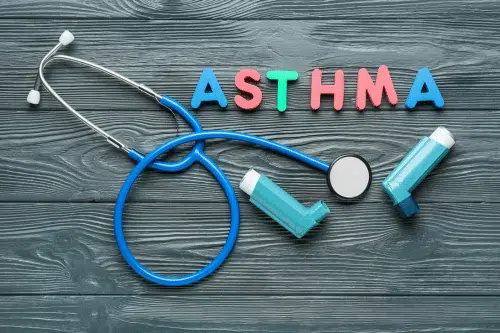- September 24, 2025
Table of Contents
ToggleChildhood Asthma: Can You Grow Out of Asthma & Key Signs
Watching your child struggle to breathe is terrifying for any parent. Terms like “reactive airway disease in childhood,” “labored breathing in toddler,” or a “high pitched” whistle during “wheezing in toddlers when to worry” moments can feel overwhelming. A child symptom like a persistent cough, especially a “counter cough medicines” can’t fix, is a major red flag. This guide will help you understand the signs, triggers like “asthma from cold virus,” and answer the pressing question: can you grow out of asthma? Most importantly, it will emphasize a crucial message from pulmonologists: with proper management starting early, a child with asthma can lead a completely normal, active life. The goal is not just to treat attacks, but to prevent them entirely.
Can You Grow Out of Asthma?
This is one of the most common questions parents have. The answer brings hope: yes, many children can outgrow their asthma symptoms. Studies show that a significant number of kids see their symptoms disappear or become much less severe as they enter their teenage years. Their airways grow larger and become less reactive. However, it’s not a guarantee. For some, asthma is a lifelong condition. The most critical point is that whether a child outgrows it or not, well-controlled asthma from the start allows them to live a full, normal life. Early and consistent management is the key to controlling inflammation, preventing long-term lung damage, and ensuring they can participate in all activities. The severity of a child’s asthma, family history, and the presence of other allergies play a significant role in determining this outcome. Therefore, while optimism is justified, maintaining a proactive management plan with your pediatrician is crucial throughout childhood.
The Primary Goal: Preventing Attacks, Not Just Treating Them
The modern approach to asthma care focuses on prevention. We do not want to wait for a frightening “child shortness of breath at rest” episode to occur. Instead, the partnership between parents and the pediatrician should begin at diagnosis to create an “Asthma Action Plan.” This plan is your roadmap to daily maintenance and early intervention, designed to avoid emergency situations altogether. Central to this plan are controller medications, often delivered via inhalers. It is a common misconception that inhalers are only for severe cases or older children. Inhalers can and are safely used from very early ages; they are the most effective way to deliver medicine directly to the lungs. Being on board with your doctor from the start ensures your child’s asthma is managed proactively, not reactively.
Recognizing Labored Breathing in Toddler
It’s crucial to distinguish normal breathing from a sign of distress. Labored breathing in toddler might look like:
- Their stomach muscles working hard to pull in air, visible as abdominal “see-sawing.”
- The skin between their ribs or above their collarbone sucking in with each breath (a sign the child is breathing with extreme difficulty).
- Flaring nostrils with each breath attempted.
- Inability to speak more than a few words or eat due to breathlessness.
- A look of panic or anxiety in their eyes.
Wheezing in Toddlers: When to Worry
Not all wheezing is a medical emergency. Mild wheezing might occur with a simple cold. However, you should seek immediate medical attention if your child’s symptoms escalate to shortness of breath at rest accompanied by:
- Fast, shallow breathing.
- A persistent, high pitched whistling sound.
- A pale or bluish tint to the lips, face, or nail beds. This indicates their body is not getting enough oxygen.
Understanding Asthma From Cold Virus
Viral infections, especially the common cold virus, are the most common trigger of asthma attacks in young children. This is why many kids experience severe coughing and wheezing that lasts long after the runny nose is gone. The virus causes inflammation in the already sensitive airways. This is often mistaken for a “bad chest cold,” but its repetitive nature is a classic indicator of underlying asthma.
Reactive Airway Disease in Childhood
This term is often used for very young children where a definitive asthma diagnosis is tricky. It describes the same common in young children condition where the
airways overreact to a trigger. The treatment and management strategies are virtually identical—focusing on preventing reactions.
Proactive Home Management: Beyond Moist Air
While moist air from a humidifier can help, comprehensive environmental control is vital for prevention. Key steps include:
Allergen Control: Regularly wash bedding in hot water, vacuum carpets frequently, and dust curtains. If your child is allergic, it may be necessary to find a new home for pets or keep them out of the bedroom.
- Strict Hygiene: Maintain a clean home to reduce dust mites and mold. Avoid exposure to cigarette smoke entirely.
- Hydration and Calm: Ensure they stay hydrated and create a calm environment, as anxiety can worsen symptoms.
Asthma triggers can vary significantly from child to child and may include common culprits such as dust, pollen, pets, physical activity, or viral infections. Identifying and understanding these individual triggers is essential for effective asthma management. While avoidance is the best preventive measure, prompt use of an inhaler following exposure—before symptoms worsen—can help maintain asthma control and reduce the risk of severe flare-ups.
Ensuring a Normal Life: Sports and Activities
A key sign of well-controlled asthma is the ability to participate fully in sports and play. Does asthma cause fatigue? It can if uncontrolled, but a managed child should have the energy for normal activities. If your child experiences symptoms during exercise, your pediatrician can prescribe a pre-activity inhaler (like a bronchodilator) used 15-30 minutes before sports. This prevents exercise-induced bronchoconstriction, allowing them to play like any other child. Regular check-ups ensure their plan supports an active lifestyle.
Conclusion: A Partnership for a Normal, Active Life
Navigating childhood asthma is a partnership between you, your child, and your pediatrician. The question, can you grow out of asthma, offers hope, but the immediate goal is clear: through proactive management starting from diagnosis, your child can lead a normal life. This means using controller medications like inhalers as prescribed, rigorously managing the home environment, and working with your doctor to prevent attacks before they start. With this vigilant care, you can ensure your child’s asthma is well-controlled, allowing them to run, laugh, and breathe freely without limitation.








